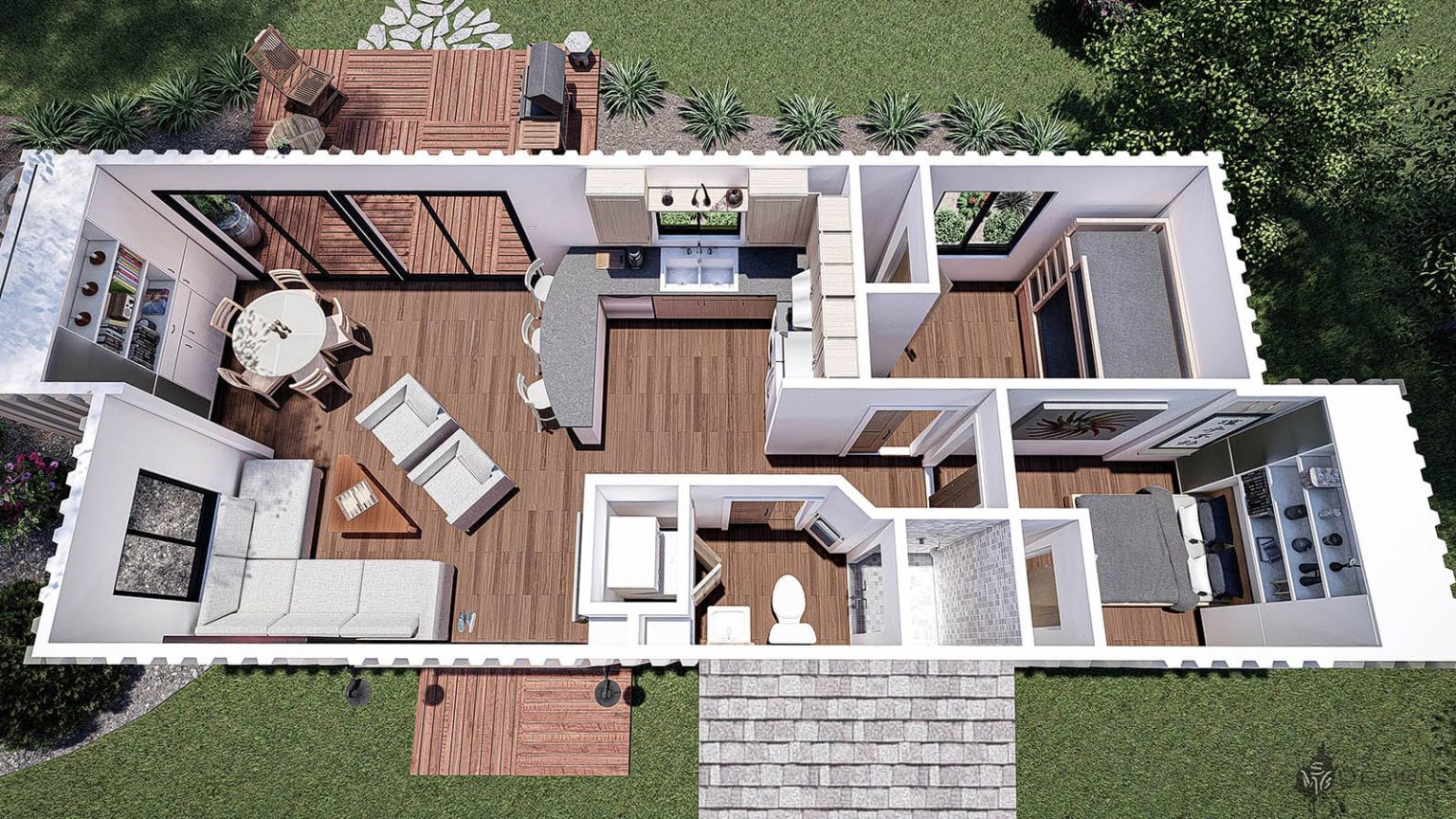Discover a world of innovative container home blueprints, transforming ordinary shipping containers into stylish and sustainable dream homes. This comprehensive guide dives into everything you need to know, from floor plans and design considerations to the pros, cons, and costs of building your own container haven.
Decoding Container Home Blueprints
Thinking about a container home? That’s exciting! These unique dwellings offer a blend of sustainability, affordability, and modern design. But before you dive in, understanding the blueprints is essential. They’re the roadmap to your dream home, outlining everything from layout and dimensions to structural elements.
Types of Container Homes and Floor Plans
Just like traditional homes, container homes come in various shapes and sizes. Here’s a breakdown:
-
Single-Container Homes: Ideal for minimalist living, guest houses, or studios. These compact spaces maximize efficiency within a single 20- or 40-foot container. Imagine a cozy retreat with a combined living area, kitchenette, bathroom, and sleeping nook. Check out examples like The Bachelor(ette) by Custom Container Living or the H03 by Honomobo.
-
Multi-Container Homes: Need more space? Combining multiple containers offers endless possibilities. Connect them side-by-side, stack them vertically, or create unique L-shaped or U-shaped designs. This allows for separate bedrooms, spacious kitchens, expansive living areas, and more. Explore designs like the Studio+ by Luckdrops for inspiration.
-
Modified Shipping Container Homes: Integrate containers with traditional construction for a hybrid approach. This offers even greater design flexibility and can be a great option for incorporating containers into existing structures.
Need floor plan ideas? Resources like RoomSketcher offer a wealth of container home layouts to spark your imagination. They often showcase open-concept designs and smart space utilization, perfect for modern living.
Designing Your Container Home: Key Considerations
Before you fall in love with a design, consider these crucial factors:
-
Insulation: Essential for comfortable living in any climate. Proper insulation keeps your home warm in winter and cool in summer, and helps manage energy costs. Explore different insulation materials and methods specifically designed for container homes.
-
Ventilation: Fresh air is key for a healthy home. Plan for adequate ventilation to prevent moisture buildup, which can lead to mold and other issues. This might involve installing vents, fans, or a whole-house ventilation system.
-
Window Placement: Maximize natural light and optimize views with strategic window placement. Consider privacy and energy efficiency when choosing window types and locations.
-
Structural Modifications: Combining or stacking containers requires careful structural planning. Consult with a structural engineer to ensure your home is safe and sound. This is especially important for multi-container designs.
DIY vs. Hiring a Builder
-
DIY: Appealing for its cost-saving potential and hands-on experience, but requires significant time, skill, and effort. It’s best suited for experienced builders or those with strong construction backgrounds. Resources like The Wayward Home offer valuable information for DIY enthusiasts.
-
Hiring a Builder: Offers expertise, streamlines the process, and ensures proper execution of complex designs and permitting. Companies like Custom Container Living and Honomobo specialize in container home construction, providing prefabricated and custom options.
Weighing the Pros and Cons
Container homes offer many advantages but also come with unique challenges. Understanding both sides is crucial for making informed decisions.
Benefits of Container Homes
-
Sustainability: Repurposing shipping containers reduces waste and promotes eco-friendly construction. You’re giving these sturdy steel boxes a new life and minimizing environmental impact.
-
Affordability (Potential): Container homes can be more budget-friendly than traditional builds, especially for smaller, simpler designs. However, costs can escalate with extensive modifications and customization.
-
Durability: Built to withstand harsh seafaring conditions, containers are inherently strong and resistant to weather, pests, and even fire.
-
Fast Construction: Prefabricated options and the modular nature of containers can significantly reduce construction time compared to traditional methods.
-
Design Flexibility: From modern minimalist to rustic industrial, containers offer a blank canvas for creative expression. Customize the exterior and interior to match your style and vision.
Potential Downsides
-
Rust Potential: Metal rusts. Regular maintenance and protective coatings are crucial to prevent and manage rust, ensuring the longevity of your container home.
-
Insulation Challenges: Achieving optimal insulation in a steel box requires careful planning and execution. Research effective insulation materials and methods tailored to container homes.
-
Transportation Costs: Getting large, heavy containers to your site can be an added expense, especially in remote locations.
-
Site Preparation: Proper site preparation, including leveling and foundation work, is essential for a stable and secure structure. Unlock the secrets of outdoor living with our concrete deck design guide, tailored to transform your outdoor space into a tranquil oasis.
-
Permitting: Building codes and regulations for container homes vary by location. Research local requirements and be prepared to navigate the permitting process, which can sometimes be more complex than for traditional homes.
Exploring Costs and Resources
The cost of a container home varies widely, influenced by factors like size, design complexity, materials, and location.
Estimating Costs
- DIY (excluding land and permits): $10,000 – $50,000 (likely higher for complex projects).
- Prefabricated (basic): $50,000 – $100,000.
- Prefabricated (custom): $100,000 – $200,000+.
- Multi-container/Luxury: $200,000+.
Resources like Container Addict provide valuable insights into container home costs, including prices for different sizes and configurations. However, remember these are estimates. Obtaining accurate quotes from builders and researching local material and labor costs is essential for your specific project.
Finding Blueprints and Builders
- Custom Container Living: Offers a range of prefabricated and custom container home designs.
- Honomobo: Known for its modern and stylish container homes and expert construction services.
- SG Blocks: Specializes in container-based construction for various applications, including residential projects.
- Pelican Containers: Provides services for finding and customizing shipping containers, giving you control from the initial stages.
Real-World Inspiration
Seeing container homes in action can spark new ideas and demonstrate the potential of this unique building method.
- Desert Alchemy: A stunning example of a multi-container home blending seamlessly with its desert surroundings.
- NYC’s first container home in Williamsburg: A testament to the versatility of containers in urban environments.
- The Box Hop: A collection of playful and innovative container structures.
- The Helm: A luxurious container home showcasing high-end design and finishes. Dive into the world of contemporary ranch house plans, where modern aesthetics meet the timeless charm of ranch-style living.
Building Your Dream: Next Steps
Ready to embark on your container home journey? These steps will help you get started:
- Define Your Needs and Budget: Determine your desired size, layout, and must-have features. Establish a realistic budget that includes all aspects of the project, from site preparation to interior finishes.
- Research and Gather Inspiration: Explore container home designs, floor plans, and real-world examples. Collect ideas and create a vision board to guide your design choices.
- Consult with Professionals: Engage with architects, builders, and structural engineers experienced in container home construction. They can provide valuable insights, create custom blueprints, and ensure your project meets building codes and safety standards.
- Secure Financing and Permits: Explore financing options specifically designed for container homes. Navigate the permitting process early on to avoid delays and ensure compliance with local regulations.
- Choose Your Builder or Embrace DIY: Decide whether to hire a professional builder or take on a DIY project. If choosing DIY, carefully assess your skills and resources.
Building a container home is an exciting adventure. With careful planning, thoughtful design, and the right resources, you can transform ordinary shipping containers into a unique and sustainable home that reflects your personality and lifestyle.
- Pontoon Boat Seat Covers: The Ultimate Guide to Protection & Buying - April 17, 2025
- Covers for Pipework: A Complete Guide to Materials, Installation & More - April 17, 2025
- Dog Patio Door Inserts: A Comprehensive Guide to Choosing & Installing - April 17, 2025










